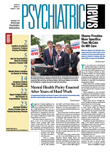I hate PACs. Political Action Committees. If you had told me 10 years ago that I would be writing this column as president of APA, that would have meant you did not know me very well. However, as I write this column, there are huge issues at stake in the United States. Who is going to decide whether we go to war, with whom, and how? Who is going to decide how to address the crisis in our financial system? Who is going to decide what kind of health care system we are going to have? Who is going to plan how psychiatric care will figure in that system? Whether there is nondiscriminatory coverage? Whether psychologists are licensed to prescribe medication? Our elected officials will decide. On what basis will they decide? There are legislative and regulatory decisions on topics ranging from highway construction to stem cell research. They can't be knowledgeable about all these topics; they have to rely on advice.
Legislators do not have time to listen to and absorb all the advice everybody would like to give them. How do elected officials in the United States decide whom to listen to? First of all, they want to be reelected. Getting reelected requires making constituents happy, but it also requires campaign money, and lots of it. I happen to think that's a terrible system, but it's the system we have.
As I understand it, giving money to candidates is considered by the United States Supreme Court to be a form of free speech. We can work to change the system, but that will require the votes of the people elected under the existing system. Second, legislators ought to listen to experts on the issues. There are only so many hours in the day. So legislators are more likely to allocate more time to advisers who give them money than to those who provide good advice alone. When it comes to mental health care, APA should be their prime source of information. Unfortunately, that takes money.
It took years to convince me to contribute to any PAC. I was surprised to learn that some of the money I was asked to donate would go to incumbents I would never have voted for. After reflecting on that for a while and getting some life experience, I recognized that strategic alliances are made not just with people who share all of our views. To accomplish good things, it is necessary to make alliances with people because they are powerful or because they agree with us in one area while disagreeing with us in others.
Contributing to APAPAC is a tangible recognition of that reality. During the 2007-2008 election cycle, 4,000 APA members and staff have given over $556,000 to APAPAC. Let's put that in context. With nearly 40,000 members, we are one of the largest medical societies in the country. Our contributions rank 10th among medical societies, after anesthesiology, orthopedics, radiology, emergency medicine, ophthalmology, pathology, general surgery, osteopathic medicine, and cardiology. We contributed to the campaigns of 134 incumbent members of and candidates for Congress and to national party committees and cohosted 103 educational and campaign events. We contributed to candidates from both parties; votes on our issues have to come from both sides of the aisle.
Here are just a couple of examples of the importance of the relationships we have built with the help of our PAC. Sen. Gordon Smith (R-Ore.) played a major role in the passage of the Medicare bill, including the elimination of the discriminatory mental health copay. Rep. John Sullivan (R-Okla.) was the major Republican advocate for mental health parity and Medicare reform in the House. He also introduced the Healthcare Truth and Transparency Act, which would require medical care providers, increasing numbers of whom are identified as “doctor,” to make it clear to patients whether or not they are physicians.
We must elect and support legislators who support us and our patients. This year has been our best year so far—as of mid-September, 1,900 APA members and staff contributed over $248,000, an increase of 42 percent in membership participation and 23 percent in dollars compared with the same period in 2007. Nonetheless, this achievement is not good enough; 93.5 percent of us are letting 6.5 percent of us carry the weight. That's not fair, is it?

